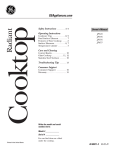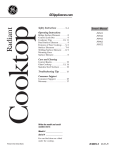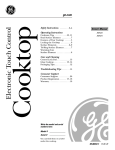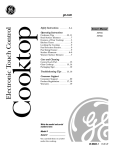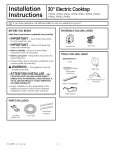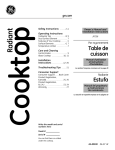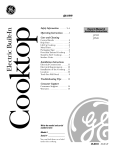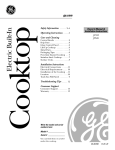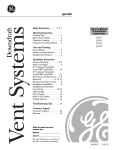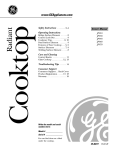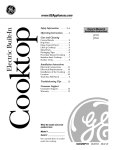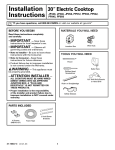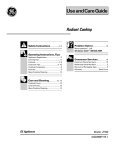Download GE JP655 User's Manual
Transcript
Radiant Cooktop ge.com Safety Instructions . . . . . . . 2–4 Operating Instructions Cookware Tips . . . . . . . . . . . .8, 9 Dual Surface Element . . . . . . . 7 Features of Your Cooktop . . . . .5 Surface Elements . . . . . . . . . 6, 7 Temperature Limiter . . . . . . . . .7 Owner’s Manual JP340 JP346 JP356 JP655 Care and Cleaning Control Knobs . . . . . . . . . . . . 10 Glass Cooktop . . . . . . . . . . 11, 12 Stainless Steel Surfaces . . . . . . 10 Troubleshooting Tips . . . . . . 13 Consumer Support Consumer Support . . . . . . . . . 18 Product Registration . . . . . 15, 16 Warranty . . . . . . . . . . . . . . . . . 17 Write the model and serial numbers here: Model # _____________ Serial # _____________ You can find them on a label under the cooktop. 49-80411-2 07-07 JR WARNING! For your safety, the information in this manual must be followed to minimize the risk of fire or explosion, electric shock, or to prevent property damage, personal injury, or loss of life. SAFETY PRECAUTIONS When using electrical appliances, basic safety precautions should be followed, including the following: Operating Instructions Safety Instructions IMPORTANT SAFETY INFORMATION. READ ALL INSTRUCTIONS BEFORE USING. ■ Use this appliance only for its intended use as described in this manual. ■ Do not attempt to repair or replace any part of your cooktop unless it is specifically recommended in this manual. All other servicing should be referred to a qualified technician. Care and Cleaning ■ Before performing any service, disconnect the cooktop power supply at the household distribution panel by removing the fuse or switching off the circuit breaker. Troubleshooting Tips ■ Be sure your appliance is properly installed and grounded by a qualified technician in accordance with the provided installation instructions. This appliance must be supplied with the proper voltage and frequency, and connected to an individual, properly grounded branch circuit, protected by a circuit breaker or fuse acceptable for the indicated wattage on the name plate. cooktop—children climbing on the cooktop to reach items could be seriously injured. ■ Always keep combustible wall coverings, curtains or drapes a safe distance from your cooktop. ■ Always keep dishtowels, dish cloths, pot holders and other linens a safe distance away from your cooktop. ■ Always keep wooden and plastic utensils and canned food a safe distance away from your cooktop. They may become hot and could cause burns. ■ Never wear loose-fitting or hanging garments while using the appliance. Flammable material could be ignited if brought in contact with hot surface elements and may cause severe burns. ■ Use only dry pot holders—moist or damp pot holders on hot surfaces may result in burns from steam. Do not let pot holders touch hot surface elements. Do not use a towel or other bulky cloth. Such cloths can catch fire on a hot surface element. ■ For your safety, never use your appliance for warming or heating the room. Name plate location ■ Have the installer show you the location of the circuit breaker or fuse. Mark it for easy reference. Consumer Support ■ Do not leave children alone—children should not be left alone or unattended in an area where an appliance is in use. They should never be allowed to sit or stand on any part of the appliance. ■ Teach children not to play with the controls or any other part of the cooktop. ■ Do not allow anyone to climb, stand or hang on the cooktop. ■ 2 CAUTION: Items of interest to children should not be stored in cabinets above a ■ Do not use water on grease fires. Never pick up a flaming pan. Turn the controls off. Smother a flaming pan on a surface element by covering the pan completely with a well-fitting lid, cookie sheet or flat tray. Use a multi-purpose dry chemical or foam-type extinguisher. ■ Flaming grease outside a pan can be put out by covering with baking soda or, if available, by using a multi-purpose dry chemical or foam-type fire extinguisher. ■ Do not flame foods on the cooktop. If you do flame foods under the hood, turn the fan on. ■ Do not let cooking grease or other flammable materials accumulate on the cooktop. WARNING! SAFETY PRECAUTIONS 3 Consumer Support Cook meat and poultry thoroughly—meat to at least an INTERNAL temperature of 160°F and poultry to at least an INTERNAL temperature of 180°F. Cooking to these temperatures usually protects against foodborne illness. Troubleshooting Tips COOK MEAT AND POULTRY THOROUGHLY… Care and Cleaning ■ Use little fat for effective shallow or deep-fat frying. Filling the pan too full of fat can cause spillovers when food is added. ■ If a combination of oils or fats will be used in frying, stir together before heating, or as fats melt slowly. ■ Always heat fat slowly, and watch as it heats. ■ Use a deep fat thermometer whenever possible to prevent overheating fat beyond the smoking point. ■ Never try to move a pan of hot fat, especially a deep fat fryer. Wait until the fat is cool. ■ Do not store flammable materials near the cooktop. ■ Keep the hood and grease filters clean to maintain good venting and to avoid grease fires. ■ Do not store or use combustible materials, gasoline or other flammable vapors and liquids in the vicinity of this or any appliance. ■ Clean only parts listed in this Owner’s Manual. ■ Do not leave paper products, cooking utensils or food on the cooktop when not in use. ■ Keep cooktop clean and free of accumulation of grease or spillovers which may ignite. ■ Never heat unopened food containers. Pressure buildup may make container burst and cause injury. ■ Never leave jars or cans of fat drippings on or near your cooktop. ■ Never use your appliance for warming or heating the room. Operating Instructions ■ Do not touch surface elements. These surfaces may be hot enough to burn even though they are dark in color. During and after use, do not touch, or let clothing or other flammable materials contact the surface elements or areas nearby the surface elements; allow sufficient time for cooling first. ■ Potentially hot surfaces include the cooktop and areas facing the cooktop. ■ To minimize the possibility of burns, ignition of flammable materials and spillage, the handle of a container should be turned toward the center of the cooktop without extending over any nearby surface elements. ■ Always turn the surface element control to off before removing the cookware. ■ Use proper pan size—select cookware having flat bottoms large enough to cover the surface element heating element. The use of undersized cookware will expose a portion of the surface element to direct contact and may result in ignition of clothing. Proper relationship of cookware to surface element will also improve efficiency. ■ Never leave surface elements unattended at high heat settings. Boilovers cause smoking and greasy spillovers that may catch on fire. ■ Only certain types of glass, glass/ceramic, earthenware or other glazed containers are suitable for cooktop cooking; others may break because of the sudden change in temperature. ■ Keep an eye on foods being fried at high or medium-high heat settings. ■ Foods for frying should be as dry as possible. Frost on frozen foods or moisture on fresh foods can cause hot fat to bubble up and over the sides of the pan. Safety Instructions ge.com WARNING! RADIANT SURFACE ELEMENTS Use care when touching the cooktop. The glass surface of the cooktop will retain heat after the controls have been turned off. ■ Avoid scratching the glass cooktop. ■ Clean the cooktop with caution. If a wet The cooktop can be scratched with items sponge or cloth is used to wipe spills on such as sharp instruments, rings or other a hot surface element, be careful to avoid jewelry and rivets on clothing. steam burns. Some cleansers can produce noxious fumes if applied to a hot surface. ■ Never use the glass cooktop surface as a cutting board. ■ NOTE: We recommend that you avoid wiping any surface element areas until they ■ Do not place or store items on top of the have cooled and the indicator light has glass cooktop surface when it is not in use. gone off. Sugar spills are the exception ■ Be careful when placing spoons or other to this. Please see the Cleaning the Glass stirring utensils on glass cooktop surface Cooktop section. when it is in use. They may become hot ■ To avoid possible damage to the cooking and could cause burns. surface, do not apply the cleaning cream ■ Avoid heating an empty pan. Doing so may to the glass surface when it is hot. damage the cooktop and the pan. ■ After cleaning, use a dry cloth or paper ■ Do not allow water, other liquids or grease towel to remove all the cleaning cream to remain on the cooktop. residue. Care and Cleaning Operating Instructions Safety Instructions IMPORTANT SAFETY INFORMATION. READ ALL INSTRUCTIONS BEFORE USING. ■ To minimize the possibility of burns, always be certain that the controls for all surface elements are at the off position and the entire glass surface is cool before attempting to clean the cooktop. Troubleshooting Tips ■ Do not operate the glass surface elements if the glass is broken. Spillovers or cleaning solution may penetrate a broken cooktop and create a risk of electrical shock. Contact a qualified technician immediately should your glass cooktop become broken. ■ Read and follow all instructions and warnings on the cleaning cream labels. ■ Use care when touching the cooktop. The glass surface of the cooktop will retain heat after the controls have been turned OFF. ■ Do not stand on the glass cooktop. ■ Large scratches or impacts to glass cooktops can lead to broken or shattered glass. Consumer Support READ AND FOLLOW THIS SAFETY INFORMATION CAREFULLY. SAVE THESE INSTRUCTIONS 4 ge.com Throughout this manual, features and appearance may vary from your model. 36″ model JP655 Operating Instructions 30” model (JP340) Safety Instructions Features of your cooktop. ON HOT 30” model (JP356) Care and Cleaning 30” model (JP346) ON Troubleshooting Tips ON HOT Feature Index (Features and appearances may vary.) Explained on page 6, 7 Dual Surface Element 7 Left Rear Surface Element Control Knob 6 Left Front Surface Element Control Knob 6 Surface Element ON Indicator Light 6 Right Rear Surface Element Control Knob 6 Dual Surface Element Control Knob 7 Hot Surface Indicator Light(s) 6 Dual Surface Element Selector Knob 7 Center Surface Element Control Knob 6 Right Front Surface Element Control Knob 6 Consumer Support Single Surface Element 5 Throughout this manual, features and appearance may vary from your model. How to Set At both OFF and HI the control clicks into position. You may hear slight clicking sounds during cooking, indicating the control is keeping the power level you set. About the radiant surface elements… The controls for the radiant surface elements can be set anywhere between LO and HI for an unlimited number of heat settings. With the infinite switch the element cycles on and off to maintain your selected control setting. SURFACE COOKING ;;;;;;;;;;;;; ;;;;;;;;;;;; ; ;;;; ;;; ;; ;;;;;;;; Never cook directly on the glass. Always use cookware. OFF CENTER ;;;;;;;;;;; ;;;;;;;;;;; ; ;;;; ;;; ;;;;;;;;;;; ; ;;;; ;;; ; Always center the pan on the surface element you are using. Consumer Support Troubleshooting Tips Operating Instructions Push the knob down and turn in either direction to the setting you want. When the control is in any position other than OFF, it may be rotated without pushing it down. Care and Cleaning Safety Instructions Using the surface elements. 6 The radiant cooktop features heating elements beneath a smooth glass surface. NOTE: A slight odor is normal when a new cooktop is used for the first time. It is caused by the heating of new parts and insulating materials and will disappear in a short time. NOTE: On models with light-colored glass cooktops, it is normal for the cooking zones to change color when hot or cooling down. This is temporary and will disappear as glass cools to room temperature. The surface element will cycle on and off to maintain your selected control setting. It is safe to place hot cookware (from the oven or surface) on the glass cooktop when the surface is cool. Even after the surface elements are turned off, the glass cooktop retains enough heat to continue cooking. To avoid overcooking, remove pans from the surface elements when the food is cooked. The ON indicator light will glow when any surface element is on. A HOT SURFACE indicator light will glow when any radiant element is turned on and will remain on until the surface is cooled to approximately 150°F. NOTE: ■ It comes on when the element is hot to the touch. ■ It stays on even after the element is turned off. ■ It glows brightly until the element is cooled to approximately 150°F. ■ Be sure you turn the control knob to OFF when you finish cooking. Avoid placing utensils that could become hot or plastics that could melt on the surface element until it has cooled completely. ■ Water stains (mineral deposits) are removable using the cleaning cream or full strength white vinegar. ■ Use of window cleaner may leave an iridescent film on the cooktop. The cleaning cream will remove this discoloration. ■ Don’t store heavy items above the cooktop. If they drop onto the cooktop, they can cause damage. ■ Do not use the surface as a cutting board. DRAGGING ; ; ; ; ; ;;;;;;;;;; ; ;;;; ;;; ;;;;;;;;;;; ;;;;;;;;;;;; ; ; Do not slide cookware across the cooktop because it can scratch the glass. The glass is scratch-resistant, not scratchproof. Dual Surface Element (on some models) The right front surface element has 2 cooking sizes to select from so you can match the size of the element to the size of the cookware you are using. Large surface element setting To use the large surface element, turn the SELECTOR knob to . Push down and turn the control knob to the desired setting. The element will heat the entire area contained by the larger circle. Operating Instructions Small surface element setting To use the small surface element, turn the SELECTOR knob to . Push in and turn the control knob to the desired setting. The element will only heat the area inside the smaller circle. Surface Elements Cycle On and Off Surface elements will cycle on and off to maintain the temperature you have selected. The temperature limiter may cycle the elements off while cooking if: All radiant surface elements have a temperature limiter that protects the glass cooktop from getting too hot. ■ The pan bottom is not flat. Safety Instructions ge.com ■ The pan boils dry. ■ The pan is off-center. Care and Cleaning ■ There is no pan on the element. Troubleshooting Tips Consumer Support 7 Safety Instructions Operating Instructions Selecting types of cookware. The following information will help you choose cookware which will give good performance on glass cooktops. Stainless Steel: Porcelain Enamel-Covered Cast Iron: recommended recommended As long as the cookware is covered completely with porcelain enamel, this cookware is recommended. Caution is recommended for cast-iron cookware that is not completely covered with smooth porcelain enamel, since it may scratch the glass ceramic cooktop. Aluminum: Check pans for flat bottoms by using a straight edge. heavyweight recommended Good conductivity. Aluminum residue sometimes appears as scratches on the cooktop but can be removed if cleaned immediately. Because of its low melting point, thin weight aluminum should not be used. Copper: usable, but not recommended Poor performance. May scratch the surface. recommended Stoneware: Copper Bottoms: Care and Cleaning usable, but not recommended Pans with copper bottoms may leave residue appearing as scratches. Remove any residue immediately after use. Do not let a pot boil dry. Overheated metal can bond to the glass cooktop and leave a permanent stain if it is not removed immediately. usable, but not recommended Poor performance. May scratch the surface. Use pans that match the diameter of the surface element. Cooking performance will not be as good if the cookware is either smaller or larger than the surface element. Pans with rounded, curved, ridged or warped bottoms are not recommended. For Best Results ■ Place only dry pans on the surface elements. Do not place lids on the surface elements, particularly wet lids. Do not place wet pans on the glass cooktop. Consumer Support Troubleshooting Tips Glass-Ceramic: Do not use woks with support rings on the glass cooktop. Use flat-bottomed woks on the glass cooktop. 8 ■ Do not use woks that have support rings. This type of wok will not heat on glass surface elements. ■ We recommend that you use only a flat-bottomed wok. They are available at your local retail store. The bottom of the wok should have the same diameter as the surface element to ensure proper contact. ■ Some special cooking procedures require specific cookware such as pressure cookers, deep-fat fryers, etc. All cookware must have flat bottoms and be the correct size. Observe the Following Points in Canning Right! Note: Flat-bottomed canners are required for glass cooktops. HOWEVER, DO NOT USE LARGEDIAMETER CANNERS OR OTHER LARGE-DIAMETER POTS FOR FRYING OR BOILING FOODS OTHER THAN WATER. Most syrup or sauce mixtures—and all types of frying—cook at temperatures much higher than boiling water. Such temperatures could eventually harm the glass cooktop surfaces. ( 2) starting with HOT tap water for fastest heating of large quantities of water. CAUTION: ■ Safe canning requires that harmful microorganisms are destroyed and that the jars are sealed completely. When canning foods in a water-bath canner, a gentle but steady boil must be maintained for the required time. When canning foods in a pressure canner, the pressure must be maintained for the required time. ■ After you have adjusted the controls, it is very important to make sure the prescribed boil or pressure levels are maintained for the required time. ■ Since you must make sure to process the canning jars for the prescribed time, with no interruption in processing time, do not can on any cooktop surface element if your canner is not flat. When canning, use recipes and procedures from reputable sources. Reliable recipes and procedures are available from the manufacturer of your canner; manufacturers of glass jars for canning, such as Ball and Kerr brand; and the United States Department of Agriculture Extension Service. Troubleshooting Tips Flat-bottomed canners must be used. Do not use canners with flanged or rippled bottoms (often found in enamelware) because they don’t make enough contact with the surface elements and take a long time to boil water. NOTE: If your house has low voltage, canning may take longer than expected, even though directions have been carefully followed. The process time will be shortened by: (1) using a pressure canner, and Care and Cleaning Be sure the canner fits over the center of the surface element. If your cooktop or its location does not allow the canner to be centered on the surface element, use smaller-diameter pots for good canning results. Remember that canning is a process that generates large amounts of steam. To avoid burns from steam or heat, be careful when canning. Operating Instructions Wrong! Pots that extend beyond 1″ of the surface element’s circle are not recommended for most surface cooking. However, when canning with water-bath or pressure canner, larger-diameter pots may be used. This is because boiling water temperatures (even under pressure) are not harmful to the cooktop surfaces surrounding the surface elements. Safety Instructions ge.com Consumer Support 9 Be sure electrical power is off and all surfaces are cool before cleaning any part of the cooktop. How to Remove Protective Shipping Film and Packaging Tape Carefully grasp a corner of the protective shipping film with your fingers and slowly peel it from the appliance surface. Do not use any sharp items to remove the film. Remove all of the film before using the appliance for the first time. Operating Instructions Safety Instructions Care and cleaning of the cooktop. To assure no damage is done to the finish of the product, the safest way to remove the adhesive from packaging tape on new appliances is an application of a household liquid dishwashing detergent. Apply with a soft cloth and allow to soak. NOTE: The adhesive must be removed from all parts. It cannot be removed if it is baked on. Molded rib Control Knobs Stem The control knobs may be removed for easier cleaning. Spring clip Clear groove Make sure the knobs are in the OFF positions and pull them straight off the stems for cleaning. The knobs can be cleaned in a dishwasher or they may also be washed with soap and water. Do not remove chrome accent skirt (on some models). Make sure the insides of the knobs are dry before replacing. Care and Cleaning Replace the knobs in the OFF position to ensure proper placement. Stainless Steel Surfaces (on some models) Do not use a steel wool pad; it will scratch the surface. Consumer Support Troubleshooting Tips To clean the stainless steel surface, use warm sudsy water or a stainless steel cleaner or polish. Always wipe the surface in the direction of the grain. Follow the cleaner instructions for cleaning the stainless steel surface. 10 To inquire about purchasing stainless steel appliance cleaner or polish, or to find the location of a dealer nearest you, please call our toll-free number: National Parts Center ge.com 1.800.626.2002 ge.com Normal Daily Use Cleaning ONLY use ceramic cooktop cleaner on the glass cooktop. Other creams may not be as effective. To maintain and protect the surface of your glass cooktop, follow these steps: Daily use of ceramic cooktop cleaner will help keep the cooktop looking new. Use a paper towel or cleaning pad for ceramic cooktops to clean the entire cooktop surface. Use a dry cloth or paper towel to remove all cleaning residue. No need to rinse. NOTE: It is very important that you DO NOT heat the cooktop until it has been cleaned thoroughly. Burned-On Residue WARNING: DAMAGE to your glass surface may occur if you use scrub pads other than those recommended. Use a cleaning pad for ceramic cooktops. Spread a few drops of ceramic cooktop cleaner on the entire burned residue area. For additional protection, after all residue has been removed, polish the entire surface with ceramic cooktop cleaner and a paper towel. Care and Cleaning Allow the cooktop to cool. If any residue remains, repeat the steps listed above as needed. Operating Instructions Clean your cooktop after each spill. Use ceramic cooktop cleaner. Before using the cooktop for the first time, clean it with ceramic cooktop cleaner. This helps protect the top and makes cleanup easier. Shake the cleaning cream well. Apply a few drops of ceramic cooktop cleaner directly to the cooktop. Safety Instructions Cleaning the glass cooktop. Using the included cleaning pad for ceramic cooktops, rub the residue area, applying pressure as needed. Heavy, Burned-On Residue The ceramic cooktop scraper and all recommended supplies are available through our Parts Center. See instructions under “To Order Parts” section on next page. NOTE: Do not use a dull or nicked blade. Use a single-edge razor blade scraper at approximately a 45° angle against the glass surface and scrape the soil. It will be necessary to apply pressure to the razor scraper in order to remove the residue. For additional protection, after all residue has been removed, polish the entire surface with ceramic cooktop cleaner and a paper towel. Troubleshooting Tips Allow the cooktop to cool. Consumer Support After scraping with the razor scraper, spread a few drops of ceramic cooktop cleaner on the entire burned residue area. Use the cleaning pad to remove any remaining residue. 11 Safety Instructions Operating Instructions Metal Marks and Scratches Be careful not to slide pots and pans across your cooktop. It will leave metal markings on the cooktop surface. These marks are removable using ceramic cooktop cleaner with a cleaning pad for ceramic cooktops. If pots with a thin overlay of aluminum or copper are allowed to boil dry, the overlay may leave black discoloration on the cooktop. This should be removed immediately before heating again or the discoloration may be permanent. WARNING: Carefully check the bottom of pans for roughness that would scratch the cooktop. Glass surface—potential for permanent damage. Our testing shows that if you are cooking high sugar mixtures such as jelly or fudge and have a spillover, it can cause permanent damage to the glass surface unless the spillover is immediately removed. Damage from Sugary Spills and Melted Plastic Turn off all surface elements. Remove hot pans. Wearing an oven mitt: a. Use a single-edge razor blade scraper (ceramic cooktop scraper) to move the spill to a cool area on the cooktop. b. Remove the spill with paper towels. Troubleshooting Tips Care and Cleaning Cleaning the glass cooktop. To Order Parts To order ceramic cooktop cleaner and the cooktop scraper, please call our toll-free number: Consumer Support National Parts Center 800.626.2002 Ceramic Cooktop Cleaner . . .# WX10X300 Ceramic Cooktop Scraper . . .# WX10X0302 Kit . . . . . . . . . . . . . . . . . . . . . . . .# WB64X5027 (Kit includes cream and cooktop scraper) Cleaning Pads for Ceramic Cooktops . . . . . . . . .# WX10X350 12 Any remaining spillover should be left until the surface of the cooktop has cooled. Don’t use the surface elements again until all of the residue has been completely removed. NOTE: If pitting or indentation in the glass surface has already occurred, the cooktop glass will have to be replaced. In this case, service will be necessary. ge.com Troubleshooting Tips Save time and money! Review the chart on this page first and you may not need to call for service. What To Do Surface elements will not maintain a rolling boil or cooking is slow Improper cookware being used. • Use pans which are absolutely flat and match the diameter of the surface element selected. Surface elements do not work properly A fuse in your home may be blown or the circuit breaker tripped. • Replace the fuse or reset the circuit breaker. Cooktop controls improperly set. • Check to see the correct control is set for the surface element you are using. Incorrect cleaning methods being used. • Use recommended cleaning procedures. Cookware with rough bottoms being used or coarse particles (salt or sand) were between the cookware and the surface of the cooktop. • Be sure cookware bottoms and cookware are clean before use. Use cookware with smooth bottoms. Tiny scratches are not removable but will become less visible in time as a result of cleaning. Tiny scratches or metal marks or abrasions on radiant cooktop glass surface Cookware has been slid across the cooktop surface. Areas of discoloration or dark streaks on the cooktop Hot surface on a model with a light-colored cooktop. • This is normal. The surface may appear discolored when it is hot. This is temporary and will disappear as the glass cools. Food spillovers not cleaned before next use. • See the Cleaning the glass cooktop section. Incorrect cleaning methods being used. • Use recommended cleaning procedures. Plastic melted to the surface Hot cooktop came into contact with plastic placed on the hot cooktop. • See the Glass surface—potential for permanent damage section in the Cleaning the glass cooktop section. Pitting (or indentation) of the cooktop Hot sugar mixture spilled on the cooktop. • Call a qualified technician for replacement. Frequent cycling off and on of surface elements Improper cookware being used. • Use only flat cookware to minimize cycling. See Surface elements cycle on and off section. Control knob will not turn Cooktop controls improperly set. • When the knob is in the OFF position, it must be pushed in before it can be turned. When the knob is in any other position, it can be turned without being pushed in. Consumer Support • Marks from aluminum and copper pans as well as mineral deposits from water or food can be removed with the cleaning cream. Troubleshooting Tips Improper cookware being used. Care and Cleaning Possible Causes Operating Instructions Problem Safety Instructions Before you call for service… 13 Consumer Support Troubleshooting Tips Care and Cleaning Operating Instructions Safety Instructions Notes. 14 GE Service Protection Plus™ GE, a name recognized worldwide for quality and dependability, offers you Service Protection Plus ™—comprehensive protection on all your appliances— No Matter What Brand! Benefits Include: • Backed by GE • All brands covered • Unlimited service calls • All parts and labor costs included • No out-of-pocket expenses • No hidden deductibles • One 800 number to call We’ll Cover Any Appliance. Anywhere. Anytime.* You will be completely satisfied with our service protection or you may request your money back on the remaining value of your contract. No questions asked. It’s that simple. Protect your refrigerator, dishwasher, washer and dryer, range, TV, VCR and much more—any brand! Plus there’s no extra charge for emergency service and low monthly financing is available. Even icemaker coverage and food spoilage protection is offered. You can rest easy, knowing that all your valuable household products are protected against expensive repairs. Place your confidence in GE and call us in the U.S. toll-free at 800.626.2224 for more information. *All brands covered, up to 20 years old, in the continental U.S. ✁ Cut here Please place in envelope and mail to: General Electric Company Warranty Registration Department P.O. Box 32150 Louisville, KY 40232-2150 15 Consumer Product Ownership Registration Dear Customer: Thank you for purchasing our product and thank you for placing your confidence in us. We are proud to have you as a customer! Follow these three steps to protect your new appliance investment: 1 2 3 Complete and mail your Consumer Product Ownership Registration today. Have the peace of mind of knowing we can contact you in the unlikely event of a safety modification. After mailing the registration below, store this document in a safe place. It contains information you will need should you require service. Our service number is 800.GE.CARES (800.432.2737). Model Number Read your Owner’s Manual carefully. It will help you operate your new appliance properly. Serial Number Important: If you did not get a registration card with your product, detach and return the form below to ensure that your product is registered, or register online at ge.com. ✁ Cut here Consumer Product Ownership Registration Model Number ant ort l p Im Mai ay! d To Mr. ■ Ms. ■ Mrs. ■ Serial Number Miss ■ First Name Last Name Street Address Apt. # E-mail Address* Date Placed In Use Month Zip Code State City Day Year Phone Number _ _ * Please provide your e-mail address to receive, via e-mail, discounts, special offers and other important communications from GE Appliances (GEA). GE Consumer & Industrial Appliances General Electric Company Louisville, KY 40225 ge.com 16 ■ Check here if you do not want to receive communications from GEA’s carefully selected partners. FAILURE TO COMPLETE AND RETURN THIS CARD DOES NOT DIMINISH YOUR WARRANTY RIGHTS. For more information about GEA’s privacy and data usage policy, go to ge.com and click on “Privacy Policy” or call 800.626.2224. All warranty service provided by our Factory Service Centers, or an authorized Customer Care® technician. To schedule service, on-line, 24 hours a day, visit us at ge.com, or call 800.GE.CARES (800.432.2737). Please have serial number and model number available when calling for service. Staple your receipt here. Proof of the original purchase date is needed to obtain service under the warranty. GE Will Replace: One Year From the date of the original purchase Any part of the cooktop which fails due to a defect in materials or workmanship. During this limited one-year warranty, GE will also provide, free of charge, all labor and in-home service to replace the defective part. What GE Will Not Cover: ■ Service trips to your home to teach you how to use the product. ■ Replacement of house fuses or resetting of circuit breakers. ■ Improper installation, delivery or maintenance. ■ Damage to the product caused by accident, fire, floods or acts of God. ■ Damage to the glass cooktop caused by use of cleaners other than the recommended cleaning creams and pads. ■ Incidental or consequential damage caused by possible defects with this appliance. ■ Damage caused after delivery. ■ Product not accessible to provide required service. ■ Damage to the glass cooktop caused by hardened spills of sugary materials or melted plastic that are not cleaned according to the directions in the Owner’s Manual. This warranty is extended to the original purchaser and any succeeding owner for products purchased for home use within the USA. If the product is located in an area where service by a GE Authorized Servicer is not available, you may be responsible for a trip charge or you may be required to bring the product to an Authorized GE Service location. In Alaska, the warranty excludes the cost of shipping or service calls to your home. Some states do not allow the exclusion or limitation of incidental or consequential damages. This warranty gives you specific legal rights, and you may also have other rights which vary from state to state. To know what your legal rights are, consult your local or state consumer affairs office or your state’s Attorney General. Troubleshooting Tips EXCLUSION OF IMPLIED WARRANTIES—Your sole and exclusive remedy is product repair as provided in this Limited Warranty. Any implied warranties, including the implied warranties of merchantability or fitness for a particular purpose, are limited to one year or the shortest period allowed by law. Care and Cleaning ■ Failure of the product if it is abused, misused, or used for other than the intended purpose or used commercially. Operating Instructions For The Period Of: Safety Instructions GE Electric Cooktop Warranty. Consumer Support Warrantor: General Electric Company. Louisville, KY 40225 17 Consumer Support. GE Appliances Website ge.com Have a question or need assistance with your appliance? Try the GE Appliances Website 24 hours a day, any day of the year! For greater convenience and faster service, you can now download Owner’s Manuals, order parts or even schedule service on-line. Schedule Service ge.com Expert GE repair service is only one step away from your door. Get on-line and schedule your service at your convenience 24 hours any day of the year! Or call 800.GE.CARES (800.432.2737) during normal business hours. Real Life Design Studio ge.com GE supports the Universal Design concept—products, services and environments that can be used by people of all ages, sizes and capabilities. We recognize the need to design for a wide range of physical and mental abilities and impairments. For details of GE’s Universal Design applications, including kitchen design ideas for people with disabilities, check out our Website today. For the hearing impaired, please call 800.TDD.GEAC (800.833.4322). Extended Warranties ge.com Purchase a GE extended warranty and learn about special discounts that are available while your warranty is still in effect. You can purchase it on-line anytime, or call 800.626.2224 during normal business hours. GE Consumer Home Services will still be there after your warranty expires. Parts and Accessories ge.com Individuals qualified to service their own appliances can have parts or accessories sent directly to their homes (VISA, MasterCard and Discover cards are accepted). Order on-line today, 24 hours every day or by phone at 800.626.2002 during normal business hours. Instructions contained in this manual cover procedures to be performed by any user. Other servicing generally should be referred to qualified service personnel. Caution must be exercised, since improper servicing may cause unsafe operation. Contact Us ge.com If you are not satisfied with the service you receive from GE, contact us on our Website with all the details including your phone number, or write to: General Manager, Customer Relations GE Appliances, Appliance Park Louisville, KY 40225 Register Your Appliance ge.com Register your new appliance on-line—at your convenience! Timely product registration will allow for enhanced communication and prompt service under the terms of your warranty, should the need arise. You may also mail in the preprinted registration card included in the packing material. 18 Printed in the United States Estufa Radiante ge.com Instrucciones de seguridad . . . . . . . . . . . . 2–4 Instrucciones de operación Características de su estufa . . . .5 Consejos sobre los utensilios de cocina . . . . . . . . . . . . . . . .8, 9 Elemento de superficie doble . 7 Elementos de superficie . . . . 6, 7 Limitador de temperatura . . . . .7 Manual del propietario JP340 JP346 JP356 JP655 Cuidado y limpieza Perillas de control . . . . . . . . . 10 Superficie de vidrio . . . . . 11, 12 Superficies de acero inoxidable . . . . . . . . . . . 10 Consejos para la solución de problemas . . . . . . . . . . . . . 13 Soporte al consumidor Garantía . . . . . . . . . . . . . . . . . 17 Soporte al consumidor . . . . . . 18 Escriba los números de modelo y de serie aquí: No. de modelo No. de serie Los puede encontrar en la etiqueta que está debajo de la superficie de la estufa. 49-80411-2 07-07 JR Seguridad INFORMACIÓN DE SEGURIDAD IMPORTANTE. LEA TODAS LAS INSTRUCCIONES ANTES DE SU USO. ¡ADVERTENCIA! Por su seguridad, se debe seguir la información de este manual para reducir el riesgo de incendio o explosión, descarga eléctrica o para evitar daños a la propiedad, lesiones personales o la pérdida de la vida. PRECAUCIONES DE SEGURIDAD Cuando use electrodomésticos, se deben seguir precauciones básicas de seguridad, incluyendo las siguientes: Soporte al consumidor Solucionar problemas Cuidado y limpieza Operación ■ Use este electrodoméstico sólo para el uso descrito en este manual. ■ No intente reparar o reemplazar alguna parte de su estufa a menos que se recomiende específicamente en este manual. Cualquier otro servicio se debe remitir a un técnico calificado. ■ Antes de realizar cualquier servicio, desconecte la fuente de energía de la estufa en el tablero general de distribución retirando el fusible o apagando el interruptor de circuitos. ■ Asegúrese de que un electricista calificado instale y conecte a tierra correctamente el electrodoméstico de acuerdo con las instrucciones de instalación suministradas. Este electrodoméstico debe contar con el voltaje y frecuencia adecuados, así como conectarse con un circuito derivado individual y descargado a tierra adecuadamente, protegido por un cortacircuitos o fusible aceptable para el vataje indicado en el rótulo. Ubicación del rótulo ■ Pida al instalador que le muestre la ubicación del interruptor de circuitos o fusible. Márquelo para una fácil referencia. ■ No deje a los niños solos o sin supervisión en una zona donde un electrodoméstico está en uso. Nunca se debe permitir que alguien se siente o se pare en alguna parte del electrodoméstico. ■ Enseñe a los niños a no jugar con los controles ni con ninguna otra parte de la estufa. ■ No permita que nadie salte, se pare o se cuelgue de la estufa. ■ 2 PRECAUCIÓN: No se deben guardar en los gabinetes encima de la estufa artículos de interés para los niños ya que si se suben en la estufa para alcanzar dichos artículos pueden sufrir serias lesiones. ■ Siempre mantenga el papel de colgadura o las cortinas de material combustible a una distancia prudente de la estufa. ■ Siempre mantenga las toallas y paños para platos, guantes para ollas y otros artículos de tela a una distancia prudente de la estufa. ■ Siempre mantenga los utensilios plásticos y de madera y los alimentos enlatados a una distancia prudente de la estufa. Podrían calentarse y provocar quemaduras. ■ Nunca use ropa suelta o prendas que cuelguen mientras utiliza el electrodoméstico. El material inflamable se podría prender si entra en contacto con elementos calientes de la superficie y puede causar quemaduras severas. ■ Use únicamente guantes para ollas que estén secos; los guantes húmedos en superficies calientes pueden causar quemadas por el vapor. No deje que los guantes para ollas toquen los elementos calientes de la superficie. No use toallas u otros paños gruesos que puedan arder si entran en contacto con el elemento caliente de la superficie. ■ Por su seguridad, nunca use este electrodoméstico para calentar el cuarto de la cocina. ■ No use agua para extinguir incendios de grasa. Nunca levante una olla en llamas. Apague los controles. Sofoque la olla en llamas en un elemento de la superficie cubriendo la olla completamente con una tapa que encaje bien, con una bandeja de galletas o plana. Use un extintor químico seco multiusos o de tipo espumoso. ■ Se debe sofocar la grasa encendida por fuera de la olla cubriéndola con soda cáustica o si está disponible, usando un extintor químico seco multiusos o de tipo espumoso. ■ No queme alimentos sobre la estufa. Si quema alimentos bajo la campana, encienda el ventilador. ■ No deje acumular grasas u otros materiales inflamables en la superficie. ge.com Seguridad ¡ADVERTENCIA! PRECAUCIONES DE SEGURIDAD Cocine la carne y las aves completamente. La carne se debe cocinar a una temperatura mínima INTERNA de 160° F y las aves a una temperatura mínima INTERNA de 180° F. Normalmente, cocinar a estas temperaturas protege contra enfermedades causadas por los alimentos. 3 Solucionar problemas Soporte al consumidor COCINE LA CARNE Y LAS AVES COMPLETAMENTE... Cuidado y limpieza ■ Los alimentos a freír deben estar lo más secos posible. La escarcha de los alimentos congelados o la humedad en los alimentos frescos puede hacer que la grasa caliente salpique por fuera de los lados de la olla. ■ Use poca grasa para freír incluso al sumergir los alimentos en la grasa. Llenar la olla con demasiada grasa puede resultar en derramamientos cuando se agregan los alimentos. ■ Si se usa una combinación de aceites o grasas para freír, revuelva antes de calentar, o a medida que las grasas se mezclan lentamente. ■ Siempre caliente la grasa lentamente y vigile mientras se calienta. ■ Cuando sea posible, use un termómetro para grasa para evitar sobrecalentar la grasa. ■ Nunca trate de mover una sartén con grasa caliente, especialmente una sartén profunda para freír. Espere hasta que la grasa esté fría. ■ No almacene materiales inflamables cerca de la estufa. ■ Mantenga los filtros de la campana y de la grasa limpios para mantener una buena ventilación y evitar que la grasa se encienda. ■ No almacene o use materiales combustibles, gasolina u otros vapores y líquidos inflamables en la cercanía de éste o cualquier electrodoméstico. ■ Limpie sólo las partes señaladas en este manual del propietario. ■ No deje productos de papel, utensilios de cocina o alimentos en la estufa cuando no esté en uso. ■ Mantenga la estufa limpia y libre de acumulación de grasa o derramamientos que se puedan encender. ■ Nunca caliente recipientes de alimentos sin abrir, el aumento de presión podría causar que la lata explotara u otras lesiones. ■ Nunca deje frascos o latas con restos de grasa sobre o cerca de la superficie de la estufa. ■ Nunca use este electrodoméestico para calentar el cuarto de la cocina. Operación ■ No toque los elementos de la superficie. Estas superficies pueden estar tan calientes como para quemar aunque estén de color oscuro. Durante y después de su uso, no las toque, ni permita que algún paño u otro material inflamable entre en contacto con los elementos de la superficie o con las áreas cercanas a los elementos de la superficie; deje suficiente tiempo para que se enfríen primero. ■ Las zonas potencialmente calientes son la superficie de la estufa y las áreas al frente. ■ Para reducir la posibilidad de quemaduras, el encendido de materiales inflamables y los derrames, el mango de cualquier recipiente se debe girar hacia el centro de la estufa sin extenderse hacia ningun elemento cercano de la superficie. ■ Apague siempre el control del elemento de la superficie antes de retirar el recipiente. ■ Use sartenes de tamaño apropiado. Seleccione aquellas que tengan fondos planos suficiente para cubrir el elemento de calentamiento del elemento de la superficie. El uso de ollas o sartenes de menor tamaño expondrá una porción del elemento de la superficie al contacto directo y puede causar que la ropa se encienda. La relación correcta de la olla o sartén con respecto al elemento también mejorará la eficiencia. ■ Nunca deje los elementos de la superficie sin atención en niveles de alta temperatura. Hervir en exceso causa humaredas y derramamientos de grasa que se pueden encender. ■ Sólo ciertos tipos de vidrios, vidrio/cerámica, vajillas de barro u otros recipientes de vidrio son adecuados para cocinar en la superficie de la estufa; otros se podrían romper debido a un cambio brusco de temperatura. ■ Vigile los alimentos mientras se fríen a niveles de temperatura altos o medios. Seguridad INFORMACIÓN DE SEGURIDAD IMPORTANTE. LEA TODAS LAS INSTRUCCIONES ANTES DE SU USO. ¡ADVERTENCIA! ELEMENTOS RADIANTES DE LA SUPERFICIE Soporte al consumidor Solucionar problemas Cuidado y limpieza Operación Tenga cuidado al tocar la estufa. La superficie de vidrio de la estufa retendrá el calor después de que se hayan apagado los controles. ■ Limpie la estufa con cuidado. Si usa una ■ Evite raspar la cubierta de vidrio de la estufa. esponja o paño para limpiar los derrames en La estufa puede rayarse con objetos tales como algún elemento de superficie caliente, tenga instrumentos puntiagudos, anillos u otros tipos cuidado y evite las quemaduras por vapor. de joyería y remaches en la ropa. Algunos limpiadores pueden producir ■ Nunca use la superficie de vidrio de la estufa emisiones tóxicas si se les aplica sobre una como una tabla para picar. superficie caliente. ■ No coloque o almacene objetos sobre la ■ NOTA: Recomendamos que evite limpiar las superficie de la cubierta de vidrio de la estufa áreas de los elementos de la superficie hasta cuando no esté en uso. que se hayan enfriado y la luz indicadora ■ Tenga cuidado al momento de colocar cucharas se haya apagado. Los derrames de azúcar son u otros utensilios para agitar sobre la cubierta la excepción a esta recomendación. Consulte de vidrio de la estufa mientras esté en uso. la sección Limpieza de la cubierta de vidrio de Podrían calentarse y provocar quemaduras. la estufa. ■ Evite calentar una cacerola vacía. Hacerlo ■ Para evitar la posibilidad de dañar la superficie podría dañar tanto a la estufa como la cacerola. de la estufa, no aplique la crema limpiadora ■ No deje que agua, otros líquidos o grasa a la superficie de vidrio cuando esté caliente. permanezcan sobre la estufa. ■ Después de limpiar, use un paño seco o bien ■ Para minimizar la posibilidad de quemaduras, una toalla de papel para remover los residuos asegúrese de que los controles de todos los de crema limpiadora. elementos de la superficie estén en la posición ■ Lea y siga todas las instrucciones y advertencias de apagado y que toda la superficie de vidrio de las etiquetas de la crema limpiadora. de la estufa esté fría antes de limpiarla. ■ Tenga cuidado al tocar la estufa. La superficie ■ No opere los elementos superficiales de vidrio de vidrio de la estufa retendrá el calor después si el vidrio está roto. Los derrames o la solución de que los controles se hayan colocado en la limpiadora pueden penetrar en una estufa rota posición OFF. y crear el riesgo de un shock eléctrico. Si la ■ No se pare sobre la estufa con cubierta cubierta de vidrio de su estufa llegara a de vidrio. romperse, póngase en contacto con un técnico calificado de inmediato. ■ Los rayones o impactos severos sobre las estufas con cubierta de vidrio podrían romper o astillar el vidrio. LEA Y SIGA ESTAS INSTRUCCIONES DE SEGURIDAD CUIDADOSAMENTE. CONSERVE ESTAS INSTRUCCIONES 4 Características de su estufa. ge.com Seguridad A lo largo de este manual, las características y apariencia pueden variar con los de su modelo. Modelo de 36″ JP655 Modelo de 30” (JP340) Operación ON HOT Modelo de 30” (JP356) Cuidado y limpieza Modelo de 30” (JP346) ON Índice de características (Las características y la apariencia puede variar.) Se explica en la página Elemento de superficie simple 6, 7 Elemento de superficie doble 7 Perilla de control del elemento de superficie posterior izquierdo 6 Perilla de control del elemento de superficie frontal izquierdo 6 Luz indicadora del elemento de superficie en posición de ENCENDIDO (ON) 6 Perilla de control del elemento de superficie posterior derecho 6 Perilla de control del elemento de superficie doble 7 Luz(ces) indicadora(s) de superficie caliente 6 Perilla de selección del elemento de superficie doble 7 Perilla de control del elemento de superficie central 6 Perilla de control del elemento de superficie frontal derecho 6 5 Solucionar problemas Soporte al consumidor ON HOT A lo largo de este manual, las características y apariencia pueden variar con los de su modelo. Cómo operar Presione la perilla hacia abajo y gire en una u otra dirección para ajustar a su gusto. Cuando el control esté en otra posición que no sea apagado (OFF), puede girarse sin necesidad de presionarlo. En las posiciones apagado (OFF) y alto (HI) el control encaja en su sitio. Puede escuchar algunos chasquidos mientras cocina, lo que indica que el control está manteniendo el nivel de calor que usted ajustó. Operación Seguridad Cómo usar los elementos de superficie. Soporte al consumidor Solucionar problemas Cuidado y limpieza Los controles para los elementos de superficie pueden ajustarse entre bajo (LO) y alto (HI) para un número ilimitado de ajustes de calor. Con el interruptor, los ciclos de los elementos se encienden y apagan para mantener el ajuste de control de su elección. Se encenderá la luz indicadora cuando cualquier elemento de superficie está encendido. Se encenderá una luz indicadora de SUPERFICIE CALIENTE cuando se encienda algún elemento radiante; la luz permanecerá encendida hasta que la superficie se enfríe aproximadamente hasta 150 °F. NOTA: ■ Se enciende cuando el elemento está caliente al tacto. ■ Permanece encendida incluso después de que el elemento se apaga. ■ Brilla intensamente hasta que el elemento se enfríe a aproximadamente 150 °F. ■ Asegúrese de apagar la perilla de control cuando termine de cocinar. Acerca de los elementos de superficie radiantes… SURFACE COOKING ;;;;;;;;;;;;; ;;;;;;;;;;;; ; ;;;; ;;; ;; ;;;;;;;; Nunca cocine directamente sobre el vidrio. Siempre use piezas de cocina. OFF CENTER ;;;;;;;;;;; ;;;;;;;;;;; ; ;;;; ;;; ;;;;;;;;;;; ; ;;;; ;;; ; Siempre coloque la cacerola en el centro del elemento de superficie en la que está cocinando. La estufa radiante tiene elementos calentadores por debajo de una superficie suave de vidrio. NOTA: Un olor ligero es normal cuando una estufa nueva es usada por primera vez. Esto es causado por el calentamiento de las partes nuevas y los materiales de aislamiento y desaparecerá en corto tiempo. ■ Las manchas de agua (depósitos de minerales) se remueven usando una crema de limpieza o vinagre blanco puro. NOTA: En algunos modelos de estufas con vidrios con colores ligeros, es normal que la zona de cocinado cambie de color cuando se calienta o cuando se enfría. Esto es temporal y desaparecerá conforme el vidrio se enfría a temperatura ambiente. ■ El uso de limpiador de ventanas podría dejar una película iridiscente sobre la estufa. La crema de limpieza removerá esta decoloración. El elemento de superficie hará ciclo entre encendido y apagado para mantener los controles de su selección. ■ No use la superficie como tabla de corte. Es seguro colocar una pieza de cocina caliente del horno o de la superficie sobre la superficie de vidrio cuando la superficie está fría. Aún después de que los elementos de superficie son apagados, la estufa de vidrio retiene suficiente calor para continuar cocinando. Para evitar cocinar excesivamente, remueva las cacerolas de los elementos de superficie cuando la comida se haya cocinado. 6 Evite colocar utensilios que podrían sobrecalentarse o plásticos que podrían derretirse sobre el elemento de superficie hasta que se haya enfriado por completo. ■ No almacene artículos pesados sobre la estufa. Si se caen sobre la estufa, podrían dañarla. DRAGGING ; ; ;;;;;;;;;;;;; ; ;;;; ;;; ;;;;;;;;;;; ;;;;;;;;;;;; ; ;;;; ;;; No deslice cacerolas encima de la superficie de la estufa porque esto podría rasguñar el vidrio. El vidrio es resistente, pero no es a prueba de rasguños. ge.com El elemento de superficie frontal derecho cuenta con 2 tamaños de cocción para su elección, de modo que puede ajustar el tamaño del elemento con el tamaño del utensilio que está usando. Ajuste de elemento de superficie pequeño Ajuste de elemento de superficie grande Operación Para usar el elemento de superficie grande, gire la perilla de SELECCIÓN a . Presione y gire la perilla de control al ajuste deseado. El elemento calentará el área completa contenida en el círculo grande. Para usar el elemento de superficie pequeño, gire la perilla de SELECCIÓN a . Presione y gire la perilla de control al ajuste deseado. El elemento sólo calentará el área dentro del círculo pequeño. Ciclos de encendido y apagado de los elementos de superficie Los elementos de superficie intercalarán ciclos de encendido y apagado para mantener la temperatura de su elección. El limitador de temperatura puede intercalar los ciclos a apagado durante la cocción si: Todos los elementos de superficie radiantes cuentan con un limitador de temperatura que evita que la cubierta de vidrio de la estufa se caliente demasiado. ■ Después de hervir el líquido contenido en la cacerola se evapora. Seguridad Elemento de superficie doble (en algunos modelos) ■ El fondo de la cacerola no es plano. Cuidado y limpieza ■ La cacerola está fuera del centro. ■ No hay ninguna cacerola sobre el elemento. Solucionar problemas Soporte al consumidor 7 Seguridad Cómo seleccionar los tipos de utensilios. La información siguiente le ayudará a escoger piezas de cocina que le darán un mejor rendimiento sobre su estufa de vidrio. Acero inoxidable: recomendable Operación Aluminio: Verifique que los fondos de las cacerolas estén planos usando una tablilla derecha. Se recomienda el uso de aluminio pesado Buena conductividad. Los residuos de aluminio a veces tienen la apariencia de raspones sobre la estufa, pero pueden eliminarse si se limpian de inmediato. Debido a su punto de fusión bajo, no debe usarse aluminio ligero. recomendable El uso de este tipo de utensilios es recomendable siempre que estén cubiertos por completo con porcelana esmaltada. Se recomienda tener cuidado con utensilios de hierro fundido que no estén cubiertos por completo con esmalte de porcelana, ya que podrían rayar la cubierta de vidrio de la estufa. Vidrio-cerámica: Cobre: recomendable Fondos de cobre: Cuidado y limpieza Soporte al consumidor Solucionar problemas Hierro fundido con porcelana esmaltada: No se recomienda el uso de cacerolas con fondos redondeados, curveados, con protuberancias o pandeados. puede usarse, per no se recomienda Las cacerolas con fondos de cobre pueden dejar residuos con la apariencia de raspones. Elimine cualquier residuo inmediatamente después del uso. No deje que el líquido hirviendo en una cacerola se evapore. El metal sobrecalentado puede adherirse a la cubierta de vidrio de la estufa y dejar una mancha permanente si no se retira de inmediato. Puede usarse, pero no se recomienda Bajo rendimiento. Podría raspar la superficie. Cerámica de gres: Puede usarse, pero no se recomienda Bajo rendimiento. Podría raspar la superficie. Use cacerolas que correspondan con el diámetro del elemento de superficie. El desempeño de cocción no será bueno si los utensilios son más pequeños o más grandes que el elemento de superficie. Para obtener mejores resultados No coloque cacerolas mojadas sobre la cubierta de vidrio de la estufa. No use woks con anillos de soporte sobre la cubierta de vidrio de la estufa. Use woks con fondo plano sobre la cubierta de vidrio de la estufa. 8 ■ Coloque únicamente cacerolas secas sobre los elementos de superficie. No coloque tapas sobre los elementos de superficie, en especial tapas mojadas. ■ No use woks con anillos de soporte. Este tipo de wok no se calentará sobre elementos de superficie de vidrio. ■ Recomendamos que use únicamente woks con fondo plano. Están disponibles en su tienda local. El fondo del wok debe ser del mismo diámetro que el elemento de superficie para garantizar un contacto adecuado. ■ Algunos procedimientos especiales de cocción requieren utensilios específicos tales como estufas de presión, freidoras de aceite, etc. Todos los utensilios deben contar con fondos planos y ser del tamaño correcto. ge.com Seguridad Siga los siguientes puntos para la preparación de enlatados ¡Correcto! ¡Incorrecto! Deben emplearse enlatadoras de fondo plano. No use enlatadoras con fondos rebordeados u ondulados (con frecuencia en utensilios esmaltados), debido a que no tienen el contacto suficiente con los elementos de superficie y requiere más tiempo hervir el agua. ( 2) si comienza con agua del grifo CALIENTE para un calentado más rápido de cantidades mayores de agua. PRECAUCIÓN: ■ El enlatado seguro requiere la destrucción de microorganismos dañinos y que los frascos estén completamente sellados. Cuando enlate alimentos con una enlatadora de baño María, debe mantenerse un hervor ligero pero constante durante el tiempo requerido. Cuando enlate alimentos con una enlatadora a presión, debe mantenerse la presión durante el tiempo requerido. ■ Una vez que haya ajustado los controles, es muy importante que se asegure que los niveles de hervor o presión prescritos se mantengan durante el tiempo requerido. ■ Debido a que debe asegurarse de enlatar durante el tiempo prescrito, sin interrupción alguna durante el período del proceso, no enlate sobre ningún elemento de superficie de la estufa si su enlatadora no es plana. Cuando enlate, use recetas y procedimientos que provengan de fuentes confiables. Las recetas y procedimientos de fuentes confiables están disponibles a través del fabricante de su enlatadora; fabricantes de frascos de vidrio para enlatar, tales como la marca Ball and Kerr, y el Servicio de Extensión del Departamento de Agricultura de EE.UU. 9 Solucionar problemas Soporte al consumidor Asegúrese de que la enlatadora se ajuste al centro del elemento de superficie. Si su estufa o su ubicación no permiten centrar la enlatadora sobre el elemento de superficie, use cacerolas de menor diámetro para obtener mejores resultados de enlatado. NOTA: Si su casa cuenta con un voltaje bajo, el enlatado puede tomar más tiempo del esperado, incluso si se han seguido las instrucciones cuidadosamente. El tiempo del proceso disminuirá si: (1) usa una enlatadora a presión, y Cuidado y limpieza NO OBSTANTE, NO USE ENLATADORAS DE GRANDES DIÁMETROS U OTRAS CACEROLAS GRANDES PARA FREÍR O HERVIR ALIMENTOS QUE NO SEAN AGUA. La mayoría de las mezclas de jarabe o salsa (y todos los tipos de fritura) se cuecen a temperaturas más elevadas que la del agua hirviendo. Tales temperaturas podrían eventualmente dañar la superficie de la cubierta de vidrio de la estufa. Recuerde que el enlatado es un proceso que genera gran cantidad de vapor. Para evitar quemaduras debidas al vapor o calor, tenga cuidado al enlatar. Operación Nota: Las enlatadoras con fondo plano son necesarias para las estufas con cubierta de vidrio. Las cacerolas que tengan una superficie mayor a 1″ del círculo del elemento de superficie no se recomiendan para la mayor parte de la cocción sobre la superficie. No obstante, cuando enlate por medio de baño María o un elemento de presión, pueden usarse cacerolas de mayor diámetro. Esto es debido a que las temperaturas del agua hirviendo (incluso bajo presión) no dañan las superficies de la estufa alrededor de los elementos de superficie. Asegúrese que la corriente eléctrica esté apagada y de que las superficies estén frías antes de limpiar cualquier parte de la estufa. Cómo retirar la película protectora y la cinta adhesiva de empaque Tome cuidadosamente una esquina de la película protectora y despéguela lentamente de la superficie del aparato. No use ningún objeto puntiagudo para retirar la película. Retire toda la película antes de usar el aparato por primera vez. Estría moldeada Perillas de control Vástago Las perillas de control pueden retirarse para facilitar la limpieza. Cuidado y limpieza Gancho con resorte Soporte al consumidor Solucionar problemas Para asegurarse de no dañar el acabado del producto, la manera más segura de retirar el adhesivo de la cinta de empaque sobre aparatos nuevos es la aplicación de un detergente doméstico líquido para lavar platos. Aplique con un paño suave y moje. NOTA: Debe retirar el adhesivo de todas las partes. No puede retirarse si se quema. Operación Seguridad Cuidado y limpieza de la estufa. Ranura transparente Asegúrese de que las perillas estén en la posición apagado (OFF) y jálelas directamente del vástago para su limpieza. Las perillas pueden limpiarse en un lavavajillas o bien lavarse con agua y jabón. No retire el borde dorado decorativo (disponible en algunos modelos). Asegúrese que el interior de las perillas esté seco antes de colocarlas de nuevo en la estufa. Coloque las perillas de nuevo en la posición apagado (OFF) para garantizar una colocación correcta. Superficies de acero inoxidable (en algunos modelos) No use una almohadilla de lana de acero; rayará la superficie. Para limpiar la superficie de acero inoxidable, use agua jabonosa con poca espuma o bien un limpiador o abrillantador para acero inoxidable. Siempre limpie la superficie en la dirección del grano. Siga las instrucciones del limpiador para limpiar la superficie de acero inoxidable. 10 Para recibir información acerca de dónde comprar limpiador o abrillantador para acero inoxidable con su distribuidor local más cercano, llame a nuestro número gratuito: Centro de piezas nacional ge.com 1.800.626.2002 Cómo limpiar la cubierta de vidrio de la estufa. ge.com Seguridad Limpieza durante el uso diario normal ÚNICAMENTE use limpiador de estufas de cerámica sobre la cubierta de vidrio. Otras cremas podrían no ser tan efectivas. Agite bien la crema limpiadora. Aplique unas cuantas gotas de limpiador de estufas de cerámica directamente en la estufa. Para mantener y proteger la superficie de la cubierta de vidrio de la estufa, siga los siguientes pasos: Antes de usar la estufa por primera vez, límpiela con limpiador de estufas de cerámica. Esto ayuda a proteger la parte superior y facilita la limpieza. El uso diario del limpiador de estufas ayudará a mantener el aparato como nuevo. Use un paño seco o una toalla de papel para remover los residuos del limpiador. No es necesario enjuagar. NOTA: Es muy importante que NO caliente la estufa sino hasta que esté completamente limpia. Operación Limpie su estufa después de cada derrame. Use limpiador para estufas de cerámica. Use una toalla de papel o almohadilla limpiadora para estufas de cerámica para limpiar toda la superficie de la estufa. Residuos quemados Deje enfriar la estufa. Use una almohadilla limpiadora para estufas de cerámica. Esparza unas cuantas gotas de limpiador para estufas de cerámica sobre toda el área con residuos quemados. Si queda algún residuo, repita los pasos arriba mencionados tantas veces como sea necesario. Para protección adicional, una vez que haya removido todos los residuos, pula toda la superficie con limpiador para estufas de cerámica y una toalla de papel. Residuos quemados difíciles de quitar Deje enfriar la estufa. El raspador para estufas de cerámica y todos los artículos recomendados están disponibles a través de nuestro Centro de piezas. Consulte las instrucciones en la sección “Para ordenar piezas” en la siguiente página. NOTA: No use una cuchilla roma o mellada. Use un raspador con una sola cuchilla a un ángulo de aproximadamente 45° contra la superficie de vidrio y raspe la mancha. Será necesario que aplique presión al raspador para remover los residuos. Para protección adicional, una vez que haya removido todos los residuos, pula toda la superficie con limpiador para estufas de cerámica y una toalla de papel. Después de raspar, esparza unas gotas de limpiador para estufas de cerámica sobre toda el área con residuos quemados. Use la almohadilla de limpieza para remover los residuos restantes. 11 Solucionar problemas Soporte al consumidor Frote el área con residuos quemados con la almohadilla de limpieza incluida, aplicando la presión necesaria. Cuidado y limpieza ADVERTENCIA: Puede DAÑAR la superficie de vidrio si usa un estropajo que no sea el recomendado. Seguridad Cómo limpiar la cubierta de vidrio de la estufa. Marcas metálicas y raspones Tenga cuidado de no deslizar cacerolas y sartenes sobre su estufa. Dejará marcas de metal sobre la superficie de la misma. Estas marcas son removibles con limpiador para estufas de cerámica y una almohadilla para limpiar estufas de cerámica. Si deja secar el líquido hirviendo en cacerolas con una capa delgada de aluminio o cobre, dicha capa podría dejar una decoloración negra sobre la estufa. Debe eliminar dicha coloración de inmediato antes de calentar otra vez; de lo contrario la decoloración podría ser permanente. Operación ADVERTENCIA: Verifique cuidadosamente el fondo de las cacerolas para comprobar si podrían rayar la estufa. Soporte al consumidor Solucionar problemas Cuidado y limpieza Superficie de vidrio—potencial para daño permanente. Nuestras pruebas demuestran que si está cocinando mezclas con un alto contenido de azúcar tales como gelatina o caramelo fundido y éstas se derraman sobre la estufa, podrían causar daños permanentes a la superficie de vidrio a menos que el derrame se limpie de inmediato. Daños causados por derrames con azúcar y plástico fundido Apague todos los elementos de superficie. Retire las cacerolas calientes. Cualquier derrame restante debe dejarse ahí hasta que la superficie de la estufa se haya enfriado. Con un guante para horno: a. Use un raspador de una sola cuchilla (raspador para estufas de cerámica) para mover el derrame a un área fría sobre la estufa. No use los elementos de superficie otra vez sino hasta que haya limpiado todos los residuos. b. Retire el derrame con toallas de papel. Para ordenar piezas Para ordenar limpiador para estufas de cerámica y el raspador para estufas, llame a nuestro número sin costo: Centro de piezas nacional 800.626.2002 Limpiador para estufas de cerámica . . . . . . . . . . . . . . .# WX10X300 Raspador para estufas de cerámica . . . . . . . . . . . . . . .# WX10X0302 Equipo . . . . . . . . . . . . . . . . . . . .# WB64X5027 (El equipo incluye la crema y el raspador para estufas) Almohadillas limpiadoras para estufas de cerámica . . .# WX10X350 12 NOTA: Si la superficie ya presenta hendiduras o agujeros, deberá reemplazar el vidrio de la estufa. En este caso, será necesario un servicio de reparación. Antes de llamar para solicitar servicio… ge.com Seguridad Ideas sobre la identificación y solución de problemas ¡Ahorre tiempo y dinero! Revise esta tabla primero y es posible que no necesite llamarnos en busca de servicio. Los elementos de superficie no se mantienen hirviendo o la cocción es lenta Los elementos de superficie no funcionan apropiadamente Está empleando • Use cacerolas que sean absolutamente planas y que los utensilios correspondan al diámetro del elemento de superficie inadecuados. seleccionado. Un fusible en su casa podría • Reemplace el fusible o reajuste el interruptor de circuitos. haberse volado o el interruptor de circuito se aterrizó. Los controles de la • Inspeccione que el control correcto haya sido estufa están colocados seleccionado para el elemento de superficie que usted inapropiadamente. seleccionó. Métodos de limpieza • Use los procedimientos de limpieza recomendados. incorrectos siendo usados. Utensilios con fondos • Cerciórese de que los fondos de los utensilios y que los rugosos están siendo usadas utensilios mismos estén limpios antes de usarlos. Use o hubo partículas gruesas utensilios con fondos lisos. No pueden eliminarse los (sal o arena) entre los raspones pequeños, pero serán menos visibles con el tiempo utensilios y la superficie como resultado de la limpieza. de la estufa. Se han deslizado utensilios sobre la superficie de la estufa. Rasguños diminutos o marcas de metal o abrasiones sobre la superficie de vidrio de la estufa radiante Áreas de decoloración o rayas oscuras en la estufa Qué hacer • Pueden eliminarse las marcas de cacerolas de aluminio y cobre, así como los depósitos minerales de agua, con la crema limpiadora. • Esto es normal. La superficie podría parecer decolorada cuando está caliente. Esto es temporal y desaparecerán conforme el vidrio se enfría. No se limpiaron los derrames de alimentos antes del siguiente uso. • Consulte la sección Cómo limpiar la cubierta de vidrio de la estufa. Se están empleando los métodos de limpieza incorrectos. • Use los procedimientos de limpieza recomendados. Plástico fundido sobre la superficie La estufa caliente entró en contacto con plástico colocado sobre ésta. • Consulte la sección Superficie de vidrio—potencial de daño permanente en la sección Cómo limpiar la cubierta de vidrio de la estufa. Agujeros (o hendiduras) en la superficie de la estufa Derrame de una mezcla • Llame a un técnico calificado para que realice azucarada caliente sobre un reemplazo. la estufa. Ciclos frecuentes de encendido y apagado de los elementos de superficie Está empleando los utensilios inadecuados. • Para minimizar los ciclos, use únicamente utensilios planos. Consulte la sección Ciclos de encendido y apagado de los elementos de superficie. La perilla de control no gira Los controles de la estufa están mal ajustados. • Cuando la perilla se encuentre en la posición apagado (OFF), deberá presionar antes de poder girarla. Cuando la perilla esté en otra posición, puede girarse sin necesidad de presionarla. 13 Solucionar problemas Soporte al consumidor Está empleando los utensilios inadecuados. Superficie caliente en un modelo con cubierta de vidrio de color claro. Cuidado y limpieza Causas posibles Operación Problema Soporte al consumidor Solucionar problemas Cuidado y limpieza Operación Seguridad Notas. 14 Notas. Seguridad Operación Cuidado y limpieza Solucionar problemas Soporte al consumidor 15 Soporte al consumidor Solucionar problemas Cuidado y limpieza Operación Seguridad Notas. 16 Garantía de GE para su estufa eléctrica. Pegue aquí su recibo. Se requiere facilitar prueba de la fecha de compra original para obtener un servicio bajo la garantía. GE reemplazará: Un año A partir de la fecha de compra original Cualquier parte de la estufa que falle debido a un defecto en los materiales o mano de obra. Durante esta garantía limitada de un año, GE también ofrecerá, sin costo alguno, toda la mano de obra y servicio interno para reemplazar las partes defectuosas. Lo que no está cubierto por GE: ■ Viajes de servicio a su hogar para enseñarle cómo usar el producto. ■ Reemplazo de fusibles de su hogar o reajuste de interruptores de circuito. ■ Instalación, entrega o mantenimiento incorrectos. ■ Daño al producto causado por accidente, fuego, inundaciones o actos de Dios. ■ Daño a la estufa de vidrio causado por el uso de limpiadores diferentes a las cremas y almohadillas recomendadas. ■ Daño incidental o consecuencial causado por posibles defectos con el aparato. ■ Daños causados después de la entrega. ■ Producto no accesible para facilitar el servicio requerido. ■ Daño a la estufa de vidrio causado por derrames endurecidos de materiales azucarados o por plástico derretido que no sean limpiados conforme a las direcciones en el Manual del propietario. Esta garantía se extiende al comprador original y cualquier comprador posterior de productos comprados para uso residencial dentro des Estados Unidos. Si el producto está situado en un área que no dispone de servicio por parte de un proveedor de servicio autorizado de GE, podría tener que hacerse cargo de los costes de envío o bien podría solicitársele que lleve el producto a una centro de servicio de GE autorizado para realizar la reparación. En Alaska, la garantía excluye el costo de envío o las visitas de servicio a su casa. Algunos estados no permiten la exclusión o las limitaciones de daños incidentales o consecuenciales. Esta garantía da derechos legales específicos, y usted podría tener otros derechos que variarán de estado a estado. Para saber cuáles son sus derechos legales, consulte a la oficina de asuntos del consumidor local o la oficina del Prucurador (Attorney General) en su localidad. Garante: General Electric Company. Louisville, KY 40225 17 Solucionar problemas Soporte al consumidor EXCLUSIÓN DE GARANTÍAS IMPLÍCITAS—Su único y exclusivo derecho es la reparación del producto, tal y como se indica en esta Garantía limitada. Cualquier garantía implícita, incluyendo las garantías implícitas de comerciabilidad o adecuación para un fin determinado, están limitadas a un año o el período de tiempo más breve permitido por la ley. Cuidado y limpieza ■ Fallas del producto si hay abuso, mal uso, o uso para otros propósitos que los propuestos, o uso para fines comerciales. Operación Por el período de: Seguridad Todos los servicios de garantía los proporcionan nuestros Centros de Reparación de Fábrica o nuestros técnicos Customer Care® autorizados. Para concertar una cita de reparación, en línea, 24 horas al día, visítenos en ge.com, o llame al 800.GE.CARES (800.432.2737). Cuando llame para solicitar servicio, por favor tenga a mano el número de serie y el número de modelo. Soporte al consumidor. Página Web de GE Appliances ge.com ¿Tiene alguna pregunta sobre su electrodoméstico? ¡Pruebe la página Web de GE Appliances 24 horas al día, cualquier día del año! Para mayor conveniencia y servicio más rápido, ya puede descargar los Manuales de los Propietarios, pedir piezas o incluso hacer una cita en línea para que vengan a realizar una reparación. Solicite una reparación ge.com El servicio de expertos GE está a tan sólo un paso de su puerta. ¡Entre en línea y solicite su reparación cuando le venga bien 24 horas al día cualquier día del año! O llame al 800.GE.CARES (800.432.2737) durante horas normales de oficina. Real Life Design Studio (Estudio de diseño para la vida real) ge.com GE apoya el concepto de Diseño Universal—productos, servicios y ambientes que pueden usar gente de todas las edades, tamaños y capacidades. Reconocemos la necesidad de diseñar para una gran gama de habilidades y dificultades físicas y mentales. Para más detalles cobre las aplicaciones de GE Diseño Universal, incluyendo ideas de diseño para la cocina para personas con discapacidades, mire nuestra página Web hoy mismo. Para personas con dificultades auditivas, favor de llamar al 800.TDD.GEAC (800.833.4322). Garantías ampliadas ge.com Compre una garantía ampliada y obtenga detalles sobre descuentos especiales disponibles mientras su garantía está aún activa. Puede comprarla en línea en cualquier momento, o llamar al (800.626.2224) durante horas normales de oficina. GE Consumer Home Services estará aún ahí cuando su garantía termine. Piezas y accesorios ge.com Aquellos individuos con la calificación necesaria para reparar sus propios electrodomésticos pueden pedir que se les manden las piezas o accesorios directamente a sus hogares (aceptamos las tarjetas VISA, MasterCard y Discover). Haga su pedido en línea hoy, 24 horas cada día o llamar por teléfono al 800.626.2002 durante horas normales de oficina. Las instrucciones descritas en este manual cubren los procedimientos a seguir por cualquier usuario. Cualquier otra reparación debería, por regla general, referirse a personal calificado autorizado. Debe ejercerse precaución ya que las reparaciones incorrectas pueden causar condiciones de funcionamiento inseguras. Póngase en contacto con nosotros ge.com Si no está satisfecho con el servicio que recibe de GE, póngase en contacto con nosotros en nuestra página Web indicando todos los detalles así como su número de teléfono o escríbanos a: General Manager, Customer Relations GE Appliances, Appliance Park Louisville, KY 40225 Registre su electrodoméstico ge.com ¡Registre su nuevo electrodoméstico en línea—cuando usted prefiera! El registrar su producto a tiempo le proporcionará, si surgiera la necesidad, una mejor comunicación y un servicio más rápido bajo los términos de su garantía. También puede enviar su tarjeta de registro pre-impresa que se incluye en el material de embalaje. 18 Impreso en los E-U
This document in other languages
- español: GE JP655




































